Building Business Processes with WEBCON BPS – an expert guide: Part 4 - Parent Workflow - Identify workflows by selected user
Part introduction
This is part 4 of my “Building Business Processes with WEBCON BPS – an expert guide” in WEBCON BPS. In the previous part we took the prototype created in part 2 enhanced it gather all workflows where the selected user has an open task. In this part we will identify all workflows which store the selected user in a person field. This can be a single or multi-value field
Tip: If you are a seasoned WEBCON BPS Designer you can scroll through this text and look out for boxes like this one. These contain tips / summaries and the like. You may find some useful information without reading everything.
Querying choose/person fields
How a choose field value is stored
This time, we only need information from the V_WFElements table. Instead of
checking the tasks we need to check the column which could contain user
information. These are all WFD_AttChoose## columns, and there a quite a lot of
them. Each field is mapped to one of the predefined columns.

Tip: The number of each field type is fixed and if your process needs a lot of fields check out the limitations.
With this knowledge we can create a SQL statement which will future proof, even workflows from new processes will be retrieved correctly.
A choice field stores a value in the format ID#Displayname. If it’s a multi
value field the values are separated by a semicolon:
Id#DisplayName;Id#Displayname
This makes our job a little tricky. First of all, we have to compare the Id of the choice field against the BPS id, which is the name of the internal user id. This should only change in a few rare cases while the display name may change due to marriage or similar.
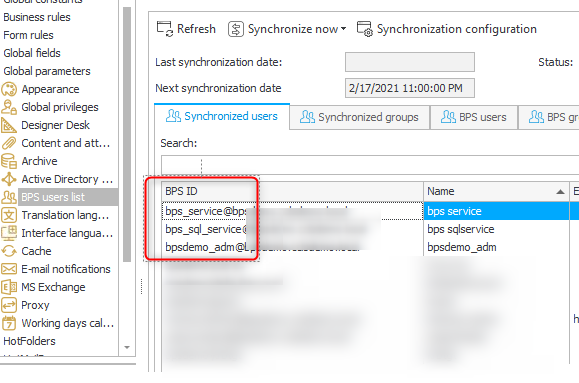
Tip: Don’t use the display name in a condition. This is bound to break. The display names are updated only when the workflow itself gets saved. Old workflows may have stored the old name. Which is correct, because it was the name at this point in time.
Extracting id or display name from a choose value
The question is how do we extract the id from the value. If you use the Objects tab from the expression editor, you will notice a few options. Each will be replaced by a different statement.

While a single value field will simply return the id, there’s a different behaviour for a multi-value field. In this case it returns string of ids which a separated by a comma.
user@example.com,user2@example.com,user3@example.com
Tip: There are a few more functions which can help you:
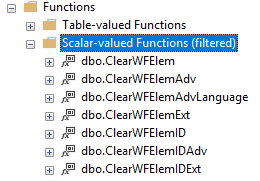
Where condition for a single and multi-value field
The second tricky bit is, that the user can be used in a single value or multi value field. We need to check each case. Since the SQL server doesn’t know a real regular expression, we have to check every possible option. These are:
- single value
- multi-value in the beginning of the string
- multi-value in the middle of the string
- multi-value in the end of the string

Without checking for the comma we may have false positives. Searching
for user@example.com would be also return true for ids like muser@example.com.
Tip: Whenever I encounter a syntax error, I will open the preview using show and copy the text over into SQL Server Management Studio. This reduces the time spend for identifying the error .
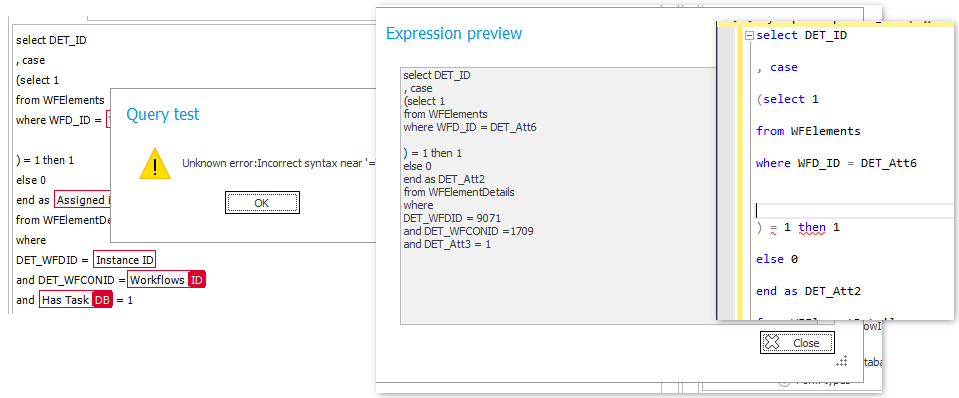
Updating an item list with additional information
The retrieval of all workflow in which the user was assigned to a field is similar to the for retrieving the tasks. Before copying it I will create a template from the action.

Tip: If you have only the slightest doubt, that you need to revisit an action, create a template from it. In this case you don’t need to look through the process and locate it, which saves you a few clicks.
Since the template action is similar to the one we need to create we can copy it twice. The first copy will be used to add only these workflows which are not already part of the item list. The second copy will update the “Assigned in Field” column for those workflow ids which were because they have an open task.
The action for adding only workflows which don’t exist yet simply checks whether the workflow instance id is already part of the item list (1). The complete statement is omitted simply because of the “is user in field check” for 90 fields.

The action for updating the “Assigned in Field” field uses a case statement which checks if the current workflow also has choose field with the BPS id of the selected user (1). If this is the case, than the field is set to true otherwise to false. It is executed for each row in the item list where “Has task” is true. Selecting the DET_ID as a unique value and retrieving it in the SQL query will ensure that the same row is updated and not some other row.
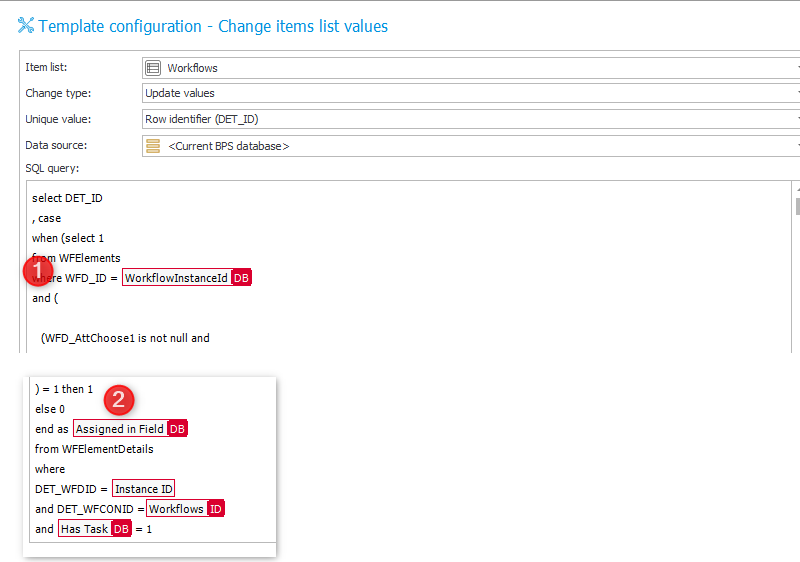
Tip: If you are in doubt how something works click on the blue i. In most
cases you will get really useful information. They helped me tremendously
learning WEBCON BPS.
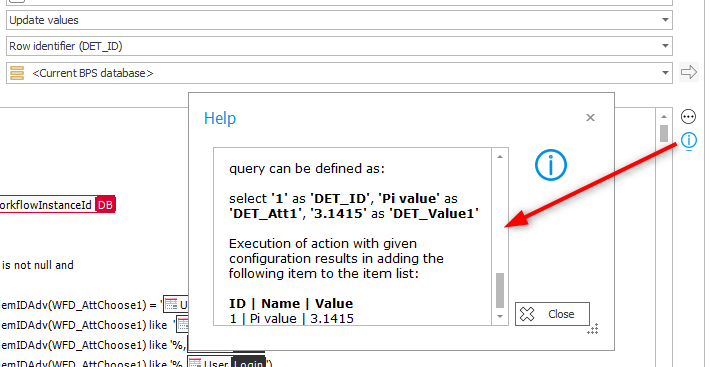
After executing all three actions our item list will look like this:

One big or multiple smaller steps
All in all, we have three actions to populate the workflow item list. Couldn’t we achieve this with one single action? That’s possible without doubt. We could create one monster select statement and it will work. Alternatively, we could declare temporary tables in which we insert data and return the result.
Tip: You can write complex SQL statements directly in the expression editor and they will be executed just fine. The only problem is that you will lose the test options. This will throw an error. You can check out this blog posts for more details: How configure form field with advanced SQL query -
There’s a simple reason why I don’t use this approach, in most cases. If there’s a problem I will have a hard time looking into it with one single action. I need to understand it (again) and check which part is causing the problem. If I have multiple small steps instead, I immediately know which part failed and I even have some data to work with. At least if not all actions are executed during the same path transition. :)
Tip: If you have a complex query it will help to split it into multiple actions. If you can, you should even add multiple steps and execute only a single action during one step to modify the data. This will allow you to take a look at the data and how it was transformed.
Tip: If there was an error during path transition, you can quickly open the step configuration of a specific workflow by pressing ctrl+g and either enter the ID or paste the URL of the workflow. There are more keyboard shortcuts.

Continuation
In the next part we will see how we can retrieve the translations of the application, process, workflow and form type which ids have been stored in the item list.
Part overview
- Introduction and Use Case
- Parent Workflow- Prototype implementation using the Designer Desk
- Parent Workflow - Prototype changes and task retrieval
- Parent Workflow - Identify workflows by selected user
- Parent Workflow - Getting translations & supervisor
- Sub Workflow - User assignment task
- Parent Workflow - Starting sub workflows & monitoring column
Download
You can download the application from here.
Comments